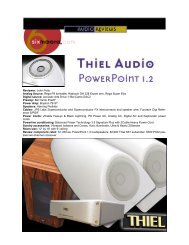You also want an ePaper? Increase the reach of your titles
YUMPU automatically turns print PDFs into web optimized ePapers that Google loves.
the length of the magnetic gap. This<br />
inversion of standard proportions has<br />
the effect that the coils do not leave<br />
the linear magnetic field even during<br />
strong excursions. To further reduce<br />
harmonic distortion, the pole pieces<br />
of all the drivers use copper sleeves.<br />
Yet it certainly isn’t necessary to<br />
know all these construction details<br />
to be able to correctly evaluate the<br />
drivers. One look at the massive cast<br />
baskets and powerful magnets is<br />
enough to recognize that we are<br />
looking at high-end speakers. Having<br />
said this, the drivers also fit<br />
excellently with the finely veneered<br />
cabinets of the CS 6. Whatever way<br />
you look at it, the <strong>Thiel</strong> speaker<br />
leaves one with a superb impression.<br />
Well, I would like to be able to<br />
tell you in great detail about my<br />
efforts to find the best room<br />
placement for the CS 6 in a tedious,<br />
detailed explaination through which<br />
all the speaker’s advantages are<br />
demonstrated to their fullest extent,<br />
but I cannot. Because the only effort<br />
that the <strong>Thiel</strong> CS 6 created for<br />
[THIEL’s German distributor] Jens<br />
Arnaschus from Sun Audio and<br />
myself, consisted of our moving it<br />
into my listening room. Once there,<br />
we placed it exactly in the same spot<br />
where the Roksan Darius and, to my<br />
surprise, also the Trenner & Friedl<br />
Gordon looked very comfortable.<br />
The distance to the side and back<br />
walls is actually in proportion to<br />
room size. Measuring from the center<br />
of the front baffle and the back side<br />
of the speaker, each distance is<br />
approximately one meter. At first<br />
The 3-layer sandwich diaphragm of the midrange driver: The bottom, coneshaped<br />
aluminum diaphragm insures mechanical rigidity and the top, flatshaped<br />
diaphragm prevents diffraction of high frequencies.<br />
Crossovers can look this concise and tidy, even if they are not mounted on printed<br />
circuit boards. Jim <strong>Thiel</strong>’s designs are committed to using the best components<br />
glance, this appears very unusual,<br />
however, because the speakers are<br />
oriented at a point that is one meter<br />
in front of the listener’s position. This<br />
square placement allows the speakers<br />
a very wide soundstage with an<br />
impressive sense of depth. This<br />
arrangement is certainly not<br />
universal, but if the standard<br />
placement rules are not taking<br />
advatage of your speakers’ strengths,<br />
you might as well try out this “askew”<br />
alternative. The requirement for<br />
success, however, is that the speakers<br />
function in a balanced and omnidirectional<br />
manner.<br />
For this reason, Jim <strong>Thiel</strong> has<br />
utilized a coaxial midrange/tweeter<br />
as well as the a phase correct<br />
crossover with the CS 6. It is<br />
therefore no surprise now that the<br />
CS 6, for one, sounded so utterly<br />
convincing in the described position.<br />
With good recordings such as RCA<br />
reissues, it was not possible to detect<br />
the location of the speakers. I could<br />
listen directly into the concert hall;<br />
the illusion was nearly perfect. The




